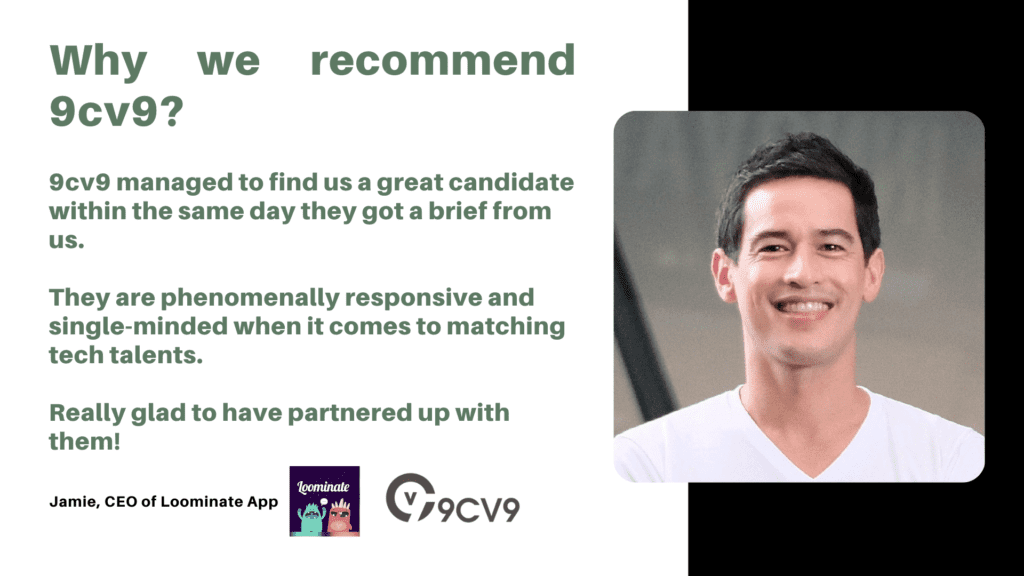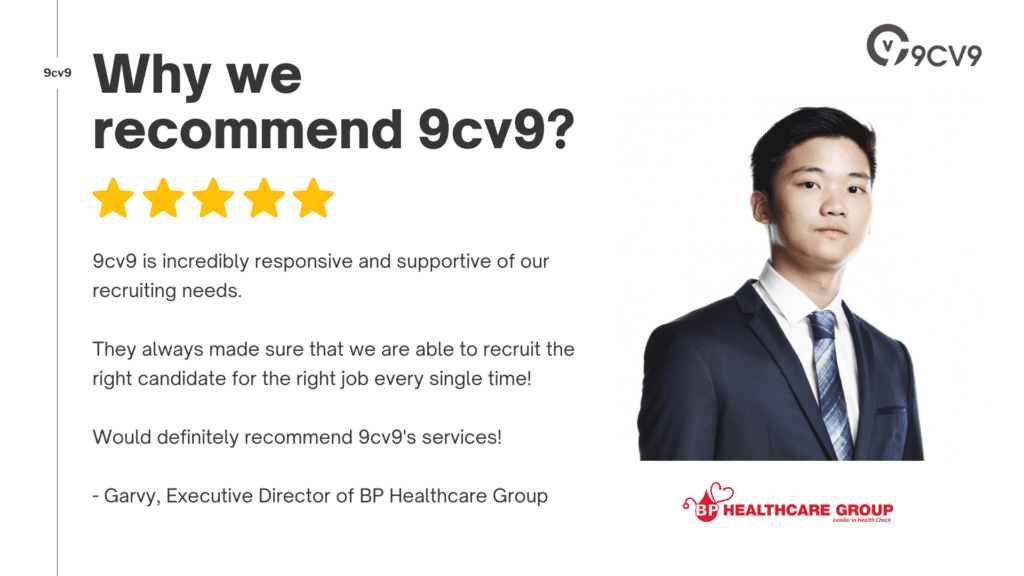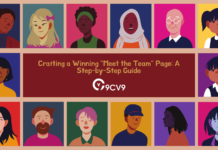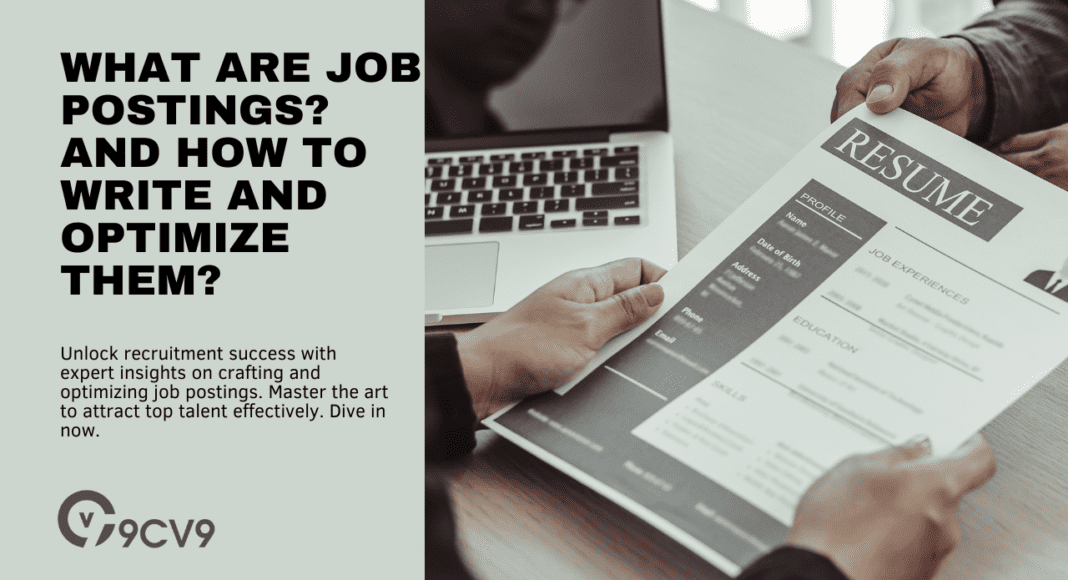Key Takeaways
- Strategic SEO Integration: Elevate your job postings with strategic SEO techniques to enhance visibility and attract a wider pool of qualified candidates.
- Visual Storytelling Mastery: Harness the power of visuals—images, videos, and infographics—to create an engaging narrative that showcases your company culture and opportunities.
- Continuous Optimization for Success: Job postings are dynamic entities; regularly update and optimize them based on analytics insights to stay relevant in the ever-evolving recruitment landscape.
In the dynamic landscape of talent acquisition and recruitment, the cornerstone lies in crafting compelling job postings that not only attract top-tier candidates but also resonate with the values and aspirations of your organization.
Job postings serve as the first point of contact between employers and potential hires, making them a pivotal element in the quest for talent.
As the digital realm continues to shape the way we communicate and search for opportunities, understanding the intricacies of job postings and mastering the art of writing and optimizing them has never been more crucial.
Whether you’re a seasoned HR professional seeking to refine your recruitment strategies or an aspiring entrepreneur aiming to build a powerhouse team, this comprehensive guide is your roadmap to creating job postings that stand out in a crowded digital landscape.
Unveiling the Essence of Job Postings
Defining the Core Components
To embark on this journey, let’s first demystify the essence of job postings.
Beyond the mere listing of job titles and responsibilities, a well-crafted job posting is a strategic communication tool that encapsulates the soul of your organization.
From the succinct job title that captures attention to the nuanced details of daily responsibilities and qualifications, each component plays a pivotal role in shaping the perception of your brand in the eyes of potential candidates.
Why Writing Matters
The importance of the written word in job postings cannot be overstated.
Beyond merely describing roles and qualifications, the language used can influence a candidate’s perception of the workplace culture, values, and overall fit within the organization.
We delve deep into the art of crafting compelling narratives within job descriptions, employing actionable language that resonates with the target audience, and strategically incorporating elements that showcase your company’s unique identity.
The Marriage of Content and SEO Optimization
Decoding the World of Keywords
In the digital age, where search engines are the gatekeepers to vast talent pools, understanding the intricacies of SEO optimization is a game-changer.
We unravel the mysteries of keyword research, guiding you through the process of selecting and strategically placing keywords to enhance the visibility of your job postings.
Learn how to align your content with the language your ideal candidates use when seeking opportunities, ensuring that your postings surface prominently in search results.
Beyond Words: Visual Elements and Mobile Optimization
In an era dominated by visual content, we explore the impact of images, videos, and infographics in enhancing the appeal of your job postings.
Moreover, as mobile devices become the primary tool for job seekers, discover the critical importance of optimizing your postings for mobile accessibility, ensuring that your opportunities are seamlessly accessible to a diverse and on-the-go audience.
Navigating the Sea of Recruitment Technology
The Role of ATS and HR Technology
As technology continues to revolutionize the recruitment landscape, we delve into the role of Applicant Tracking Systems (ATS) and other HR technology tools.
Gain insights into how these tools not only streamline the recruitment process but also influence the effectiveness of your job postings.
Realizing Success: Case Studies and Best Practices
Learning from the Masters
To bring these insights into sharp focus, we showcase real-world examples of organizations that have mastered the art of writing and optimizing job postings.
Through in-depth case studies, understand how these businesses strategically used language, visuals, and SEO tactics to attract, engage, and hire top talent.
As we embark on this exploration of job postings, be prepared to transform your recruitment approach.
This guide is not just a collection of tips and tricks; it’s a comprehensive manual designed to empower you with the knowledge and skills needed to create job postings that resonate, captivate, and ultimately drive your organization towards unparalleled success in talent acquisition.
Let’s embark on this transformative journey together, unlocking the true potential of your recruitment strategies.
What are Job Postings? And How to Write And Optimize Them?
- Understanding the Basics of Job Postings
- The Art of Writing Job Postings
- SEO Optimization for Job Postings
- Visual Elements in Job Postings
- Best Practices for Job Posting Optimization
- Tools and Resources for Job Posting Optimization
1. Understanding the Basics of Job Postings
Decoding the Anatomy of Job Postings
Components of a Job Posting
- Job Title and Summary:
- The job title serves as the initial hook for potential candidates, requiring careful consideration. It should be clear, concise, and reflect the nature of the position.
- Example: Instead of a generic “Marketing Manager,” consider a more specific and appealing title like “Digital Marketing Strategist – Igniting Growth Through Innovative Campaigns.”
- Job Responsibilities:
- Clearly outline the key responsibilities associated with the role. Use bullet points for easy readability and highlight the core tasks the candidate will undertake.
- Example: “Develop and implement comprehensive digital marketing strategies, including SEO, social media, and email marketing campaigns.”
- Qualifications and Requirements:
- Detail the essential qualifications and requirements for the position. Clearly distinguish between “must-haves” and “nice-to-haves.”
- Example: “Requirements: Bachelor’s degree in Marketing or related field; Proficiency in SEO tools; Experience with social media advertising.”
- Company Overview:
- Provide a brief but impactful overview of the company, emphasizing its mission, values, and workplace culture.
- Example: “Join our dynamic team at XYZ Company, where innovation meets collaboration. We pride ourselves on fostering a diverse and inclusive work environment.”

Significance of Clear and Concise Job Descriptions
- Crafting job postings that are both clear and concise is essential for capturing the attention of potential candidates and ensuring a positive candidate experience.
- Clarity:
- Ambiguity can lead to confusion and deter qualified candidates. Clearly articulate the role’s expectations and how it contributes to the broader organizational goals.
- Example: Instead of vague language like “assist with marketing activities,” specify tasks like “collaborate with the content team to create engaging blog posts.”
- Conciseness:
- Avoid information overload. Use concise language to convey key points, focusing on the most critical aspects of the role.
- Example: Instead of a lengthy paragraph, break down qualifications into bullet points for quick comprehension.
In mastering the basics of job postings, each element plays a crucial role in shaping the candidate’s perception and attracting the right talent.
From the job title to the company overview, attention to detail ensures a comprehensive and compelling representation of the opportunities your organization has to offer.
Also, explore our comprehensive guide on “Free Job Posting Sites: The Complete List to Boost Your Hiring Strategy.”
Discover a curated list of platforms that empower your hiring efforts without breaking the bank. From popular job boards to niche sites, this resource provides insights into maximizing your reach and attracting top-tier talent without the cost constraints.
Elevate your hiring strategy by leveraging these free job posting sites and stay ahead in the competitive recruitment landscape.
2. The Art of Writing Job Postings
Crafting an Attention-Grabbing Job Title
- Strategic Title Formulation:
- Experiment with different titles to find the right balance between creativity and clarity, incorporating industry-relevant keywords.
- Example: A title like “Innovation Catalyst” may appeal to those who value creativity and forward-thinking.
- Alignment with Branding:
- Ensure the job title aligns with your company’s brand and culture for consistency in language, contributing to a cohesive employer brand.
- Example: If your culture emphasizes collaboration, consider titles that reflect teamwork, such as “Collaboration Specialist.”
Writing Compelling Job Descriptions
a. Using Actionable Language
- Active Verbs:
- Infuse job responsibilities with strong, action-oriented verbs to convey dynamism and energy.
- Example: Instead of “Responsible for managing projects,” use “Lead cross-functional project teams for successful delivery.”
b. Highlighting Key Responsibilities
- Prioritization:
- Prioritize and emphasize critical responsibilities to give candidates a clear understanding of the role’s primary focus.
- Example: Bold key responsibilities or use a separate section to highlight critical tasks.
c. Showcasing Company Culture
- Integrating Values:
- Integrate snippets about the company’s values and culture within the job description to attract candidates who align with the organizational ethos.
- Example: “Join a dynamic team that values innovation and celebrates diversity in thought and background.”
Importance of Inclusivity and Diversity in Job Descriptions
- Gender-Neutral Language:
- Ensure job postings use inclusive language to appeal to a diverse pool of candidates.
- Example: Instead of “salesman,” use “sales representative.”
- Diversity Statements:
- Consider including a diversity statement to signal the company’s commitment to creating an inclusive workplace.
- Example: “We are an equal opportunity employer and value diversity at our company.”
Tailoring Language to the Target Audience
- Understanding Your Audience:
- Tailor the language in your job postings to resonate with your target audience. Consider the preferences and values of the demographic you want to attract.
- Example: If your target audience is tech-savvy and values innovation, use language that reflects a cutting-edge work environment.
Clarity and Transparency
a. Avoiding Jargon
- Simplicity is Key:
- Keep language straightforward and avoid industry jargon that may alienate potential candidates.
- Example: Instead of technical terms, use layman’s terms to describe job responsibilities.
b. Transparency in Job Descriptions
- Setting Realistic Expectations:
- Be transparent about the challenges and expectations associated with the role to attract candidates who are the right fit.
- Example: If the role involves frequent travel, clearly state this in the job description to set expectations.
Creating a Sense of Urgency and Exclusivity
- Highlighting Opportunities:
- Create a sense of urgency by emphasizing unique opportunities associated with the role.
- Example: “Rare opportunity to pioneer groundbreaking projects in a rapidly growing industry.”
- Limited-Time Offers:
- Incorporate language that suggests exclusivity or urgency, encouraging candidates to act promptly.
- Example: “Apply now to join an elite team shaping the future of [industry]. Limited positions available.”
Using Storytelling Techniques
- Narrative Job Descriptions:
- Infuse storytelling elements into job descriptions to make them more engaging and memorable.
- Example: Instead of a list of responsibilities, tell a brief story about the impact the role will have on the company’s success.
Fostering Engagement Through Personalization
- Addressing the Candidate Directly:
- Use second-person pronouns to address the candidate directly, creating a more personalized and engaging experience.
- Example: “You will play a crucial role in shaping our company’s success.”
- Inviting Questions and Interaction:
- Encourage engagement by inviting candidates to ask questions or providing contact information for further inquiries.
- Example: “Have questions about the role? Feel free to reach out to [contact person] at [email/phone].”
In mastering the art of writing job postings, the careful consideration of language, transparency, and engagement techniques can transform a mundane listing into a powerful recruitment tool.
By weaving in elements that reflect your company culture and appeal to your target audience, you not only attract candidates but also set the stage for meaningful connections and long-term success.
3. SEO Optimization for Job Postings
Keyword Research for Job Postings
- Identifying Relevant Keywords:
- Conduct thorough keyword research to identify terms and phrases job seekers commonly use when searching for positions.
- Example: For a marketing role, consider keywords like “digital marketing manager,” “SEO specialist,” or “content strategist.”
- Utilizing Long-Tail Keywords:
- Incorporate long-tail keywords to target specific, niche positions and capture the attention of highly qualified candidates.
- Example: Instead of “marketing manager,” use “digital marketing manager with SEO expertise.”
Strategic Placement of Keywords in Job Descriptions
- Incorporating Keywords Naturally:
- Integrate keywords seamlessly into job descriptions, ensuring that the content reads naturally and is not overly stuffed with keywords.
- Example: “Seeking a dynamic digital marketing manager with a proven track record in SEO strategy.”
- Prioritizing Key Sections:
- Place important keywords in prominent sections such as job titles, summaries, and key responsibilities to enhance visibility.
- Example: “Join our team as a Digital Marketing Manager specializing in SEO strategy.”
SEO-Friendly Meta Titles and Descriptions
- Compelling Meta Titles:
- Craft meta titles that not only include relevant keywords but are also compelling and encourage clicks.
- Example: “Unlock Your Career: Digital Marketing Manager Role with Expertise in SEO Strategy.”
- Engaging Meta Descriptions:
- Write meta descriptions that provide a concise overview of the job, incorporating keywords and a call-to-action.
- Example: “Join our innovative team as a Digital Marketing Manager, bringing your SEO expertise to drive online success. Apply now!”

Visual Elements in Job Postings
- Image and Video Optimization:
- Optimize images and videos within job postings by using descriptive filenames and incorporating relevant alt text.
- Example: For an image showcasing a collaborative team, use the filename “collaborative_team.jpg” and add alt text like “Team collaboration in action.”
- Mobile Optimization for Visuals:
- Ensure that images and videos are mobile-friendly, considering the increasing number of job seekers using mobile devices.
- Example: Use responsive design to ensure images adjust seamlessly to different screen sizes.
Ensuring Mobile-Friendly Job Postings
- Responsive Design:
- Implement responsive design principles to ensure that job postings are easily accessible and visually appealing on various devices.
- Example: Test the job posting on different mobile devices to ensure a consistent and user-friendly experience.
- Mobile-Optimized Content:
- Condense content for mobile users while maintaining essential information, providing a streamlined experience.
- Example: Use concise bullet points and headers to improve readability on smaller screens.
Using Infographics to Convey Information Effectively
- Infographic Design:
- Incorporate infographics to present key information visually, making complex data more digestible.
- Example: Create an infographic showcasing the company’s growth over the past year or the career progression within the organization.
- SEO-Friendly Alt Text for Infographics:
- Provide descriptive alt text for infographics to enhance accessibility and improve SEO.
- Example: Alt text for an infographic about company values could be “Infographic: XYZ Company Values.”
Regularly Updating Job Listings
- Frequent Updates:
- Regularly update job listings to show search engines that the content is current and relevant.
- Example: Refresh the posting with any changes to the role, requirements, or application process.
- Implementing Date Stamps:
- Include a date stamp on job listings to convey freshness, assuring candidates that the information is current.
- Example: “Posted on: [Date] – Recently updated to reflect our evolving needs.”
SEO optimization for job postings is a dynamic and essential aspect of modern recruitment.
By strategically incorporating keywords, optimizing visual elements, and ensuring mobile accessibility, organizations can enhance their online presence, attract qualified candidates, and stay ahead in the competitive hiring landscape.
4. Visual Elements in Job Postings: Enhancing Engagement and Impact
Importance of Visual Elements in Job Postings
- Cognitive Impact:
- Visual elements, such as images, videos, and infographics, have a profound impact on capturing attention and conveying information more effectively.
- Example: An image of a collaborative team can evoke a sense of workplace culture, instantly resonating with potential candidates.
- Branding and Recognition:
- Visual elements contribute to building a strong employer brand, aiding in brand recognition and making job postings stand out in a crowded digital landscape.
- Example: Consistent use of brand colors and imagery reinforces brand identity, fostering a cohesive visual experience.

Image and Video Optimization
- Descriptive Filenames:
- Optimize image and video filenames with descriptive terms relevant to the job and company.
- Example: Instead of “img123.jpg,” use “collaborative_team_meeting.jpg.”
- Alt Text for Accessibility and SEO:
- Provide meaningful alt text for images and videos to enhance accessibility for individuals with disabilities and improve SEO.
- Example: Alt text for an image of a diverse team could be “Diverse team collaborating on a project.”
Mobile Optimization for Visuals
- Responsive Design:
- Ensure visual elements are responsive and adapt seamlessly to different screen sizes, catering to the growing number of mobile users.
- Example: Use responsive images that scale appropriately on both desktop and mobile devices.
- Condensed Content for Mobile Users:
- Condense visual content for mobile users, maintaining essential information without overwhelming smaller screens.
- Example: Summarize key points in a concise caption below an image for easy mobile consumption.
Infographics to Convey Information Effectively
- Data Visualization:
- Use infographics to present complex information in a visually appealing and easily understandable format.
- Example: Create an infographic showcasing the company’s growth metrics, employee satisfaction rates, or career progression opportunities.
- Color and Design Consistency:
- Maintain consistency in color schemes and design elements within infographics to reinforce brand identity.
- Example: Use the company’s primary colors and fonts in infographics to align with the overall visual branding strategy.
SEO-Friendly Alt Text for Visual Elements
- Descriptive Alt Text:
- Craft descriptive alt text for visual elements, incorporating relevant keywords to improve search engine visibility.
- Example: Alt text for an image of a company event could be “Annual Team-Building Event at XYZ Company.”
- Keyword-Relevant Captions:
- Include captions for images and videos with keyword-rich content that adds context and aids in SEO.
- Example: A caption for a video showcasing workplace culture could be “Explore Our Inclusive Work Environment.”
Examples of Engaging Visual Elements in Job Postings
- Employee Testimonials:
- Feature images or video testimonials from current employees to provide authentic insights into the company culture.
- Example: Include a video snippet of employees sharing their positive experiences and growth within the company.
- Day-in-the-Life Visuals:
- Incorporate visuals that showcase a typical day in the life of employees to give candidates a realistic preview of the work environment.
- Example: Include images of team collaborations, meetings, and casual interactions to convey the company’s dynamic atmosphere.
Call-to-Action through Visuals
- Application Process Infographics:
- Design infographics that visually guide candidates through the application process, creating a seamless and engaging experience.
- Example: An infographic illustrating the step-by-step application process, from submitting a resume to the final interview.
- Inviting Interaction:
- Encourage candidates to engage with visual elements by including interactive elements, such as clickable buttons or links within images.
- Example: A “Learn More” button overlaid on an image, leading candidates to additional information about the company culture.
Visual elements in job postings play a pivotal role in shaping the candidate’s perception of the company and enhancing overall engagement.
By optimizing images, videos, and infographics for both accessibility and SEO, organizations can create visually compelling job postings that resonate with potential candidates and leave a lasting impression.
5. Best Practices for Job Posting Optimization
Regularly Updating Job Listings
- Frequent Updates:
- Regularly update job listings to demonstrate to search engines that the content is current and relevant.
- Example: Refresh the posting with any changes to the role, requirements, or application process.
- Implementing Date Stamps:
- Include a date stamp on job listings to convey freshness, assuring candidates that the information is current.
- Example: “Posted on: [Date] – Recently updated to reflect our evolving needs.”

Analyzing and Adapting to Industry Trends
- Stay Informed About Trends:
- Keep abreast of industry trends and adjust job postings accordingly to reflect evolving needs and expectations.
- Example: If remote work becomes a prevailing trend, highlight the company’s flexible work policies in job postings.
- Incorporate In-Demand Skills:
- Update job descriptions to include the latest in-demand skills and technologies, attracting candidates with relevant expertise.
- Example: For a tech role, mention proficiency in emerging programming languages or tools.
Encouraging Employee Involvement in the Process
- Employee Testimonials:
- Feature testimonials from current employees in job postings, providing authentic insights into the company culture.
- Example: “Hear from our team: [Employee Name], Marketing Manager – ‘Why I Love Working at XYZ Company.'”
- Employee Referral Programs:
- Promote employee referral programs within job postings to leverage the power of internal networks.
- Example: “Refer a friend and join our referral program – because great talent knows great talent!”
Utilizing Analytics to Measure Performance
- Implement Tracking Codes:
- Use tracking codes and analytics tools to monitor the performance of job postings, assessing click-through rates and applicant conversion.
- Example: Implement UTM parameters in the job posting link to track traffic sources and understand which platforms are most effective.
- A/B Testing Job Descriptions:
- Conduct A/B testing with different variations of job descriptions to identify the most compelling language and content.
- Example: Test two versions of a job description—one emphasizing culture and another focusing on career growth—and analyze applicant response.
Optimizing for Specific Platforms
- Tailoring Content for Platforms:
- Customize job postings for specific platforms, considering the unique features and preferences of each.
- Example: Use concise and engaging language on social media platforms, while providing more detailed information on the company website.
- Leveraging Hashtags:
- Incorporate relevant hashtags in social media job postings to increase discoverability.
- Example: “#TechJobs #InnovationOpportunity – Join our tech-savvy team and shape the future of [industry].”
Implementing Inclusive Language and Practices
- Inclusive Job Descriptions:
- Use inclusive language in job descriptions to attract a diverse pool of candidates.
- Example: Instead of “salesman,” use “sales representative” to appeal to a broader audience.
- Diversity Statements:
- Include a diversity statement in job postings to signal the company’s commitment to an inclusive workplace.
- Example: “We are an equal opportunity employer and value diversity in our workforce.”
Optimizing for Global Audiences
- Language Localization:
- Localize job postings for different regions, considering language nuances and cultural expectations.
- Example: Customize job postings for a global audience by providing translations and adapting content to regional preferences.
- Incorporating Global Keywords:
- Use keywords that resonate globally to attract a diverse pool of international candidates.
- Example: Incorporate terms like “multinational team” or “global collaboration” to convey a diverse and inclusive work environment.
Crafting Compelling Calls-to-Action
- Clear Application Instructions:
- Provide clear and concise instructions on how candidates can apply, reducing friction in the application process.
- Example: “To apply, click the ‘Apply Now’ button and attach your resume and cover letter.”
- Urgency and Encouragement:
- Infuse a sense of urgency and encouragement in calls-to-action to prompt immediate action from potential candidates.
- Example: “Don’t miss out on this exciting opportunity! Apply now and join our team of innovators.”
Monitoring and Responding to Candidate Feedback
- Collecting Candidate Feedback:
- Actively seek feedback from candidates regarding their application experience and the clarity of job postings.
- Example: Send a post-application survey to candidates to gather insights into their overall experience and areas for improvement.
- Iterative Improvements:
- Use candidate feedback to make iterative improvements to job postings and the application process.
- Example: If candidates express confusion about certain requirements, clarify and rephrase those sections in future job postings.
Optimizing job postings is an ongoing process that involves staying attuned to industry trends, leveraging analytics, and incorporating inclusive practices.
By adopting these best practices, organizations can not only attract top talent but also continually refine their approach to meet the dynamic needs of the ever-evolving recruitment landscape.
6. Tools and Resources for Job Posting Optimization
Applicant Tracking Systems (ATS)
- Automated Job Distribution:
- Utilize ATS platforms that offer automated job distribution to post openings across multiple job boards and platforms seamlessly.
- Example: 9cv9 and Workday automate the distribution process, ensuring job listings reach a wider audience.
- Application Management:
- Leverage ATS features for effective application management, allowing recruiters to streamline the screening and selection process.
- Example: 9cv9 and BambooHR provide robust application management tools, enhancing efficiency in candidate evaluation.

SEO Tools for Keyword Research
- Google Keyword Planner:
- Leverage Google’s Keyword Planner to identify relevant keywords and phrases that resonate with your target audience.
- Example: Identify key terms such as “marketing manager,” “IT specialist,” or “project coordinator” related to your job postings.
- SEMrush:
- Use tools like SEMrush to analyze competitor keywords, uncovering valuable insights to refine your own keyword strategy.
- Example: Identify the keywords your competitors are targeting in similar job postings and adjust your approach accordingly.
Job Posting Analytics Platforms
- Google Analytics:
- Implement Google Analytics to track user interactions with your job postings, providing valuable insights into user behavior.
- Example: Monitor metrics such as bounce rate, time on page, and conversion rate to assess the effectiveness of your job postings.
- Job Board Analytics:
- Leverage analytics provided by job boards to assess the performance of your postings on specific platforms.
- Example: Platforms like 9cv9 and LinkedIn offer analytics dashboards, allowing you to measure the reach and engagement of your job listings.

Visual Content Creation Tools
- Canva:
- Use Canva to create visually appealing graphics and infographics that can be embedded in your job postings.
- Example: Design eye-catching visuals showcasing company culture, employee testimonials, or day-in-the-life scenarios using Canva.
- Venngage:
- Explore Venngage for creating data-driven infographics that effectively convey complex information.
- Example: Present statistics about company growth or employee satisfaction in a visually engaging format using Venngage.
Social Media Management Tools
- Hootsuite:
- Schedule and manage social media posts across various platforms to maximize the visibility of your job postings.
- Example: Use Hootsuite to schedule posts on Twitter, LinkedIn, and Facebook, ensuring consistent and strategic promotion.
- Buffer:
- Leverage Buffer for social media analytics to measure the impact and engagement of your job postings.
- Example: Track the performance of your job announcements on different social media channels using Buffer’s analytics features.
Text Analysis Tools for Job Descriptions
- Textio:
- Utilize Textio to analyze language patterns and optimize job descriptions for maximum impact and inclusivity.
- Example: Improve the effectiveness of your job descriptions by incorporating language suggestions and avoiding biases with Textio.
- Gender Decoder Tools:
- Use gender decoder tools to ensure that job postings are free from gender-biased language, promoting inclusivity.
Mobile Optimization Tools
- Google Mobile-Friendly Test:
- Assess the mobile-friendliness of your job postings using Google’s Mobile-Friendly Test.
- Example: Ensure that your job listings pass the mobile-friendly test to enhance the user experience for candidates on smartphones and tablets.
Collaboration and Communication Tools
- Slack:
- Foster collaboration among hiring teams by using communication tools like Slack to discuss and refine job postings in real-time.
- Example: Create dedicated channels for job postings, allowing team members to provide feedback and suggestions through Slack.
- Asana:
- Utilize project management tools like Asana to keep track of tasks related to job postings, ensuring a streamlined and organized workflow.
- Example: Create tasks for each step of the job posting process, from drafting the description to promoting the listing, using Asana.
Localization and Translation Services
- Smartling:
- Explore localization services like Smartling to adapt job postings for different regions, ensuring cultural relevance and language accuracy.
- Example: Use Smartling to translate job descriptions into multiple languages, reaching a diverse global audience.
- Unbabel:
- Leverage tools like Unbabel for AI-powered language translation, facilitating effective communication with candidates from diverse linguistic backgrounds.
- Example: Use Unbabel to provide translations of job postings in real-time, promoting inclusivity in the recruitment process.
Candidate Feedback and Survey Tools
- SurveyMonkey:
- Implement survey tools like SurveyMonkey to collect feedback from candidates about their application experience and the clarity of job postings.
- Example: Create post-application surveys using SurveyMonkey, asking candidates about their journey and areas for improvement.
- Qualtrics:
- Use Qualtrics to gather comprehensive feedback from candidates, helping refine the job posting process based on their insights.
- Example: Design surveys that delve into candidate perceptions of the company, the application process, and the effectiveness of job postings using Qualtrics.
By leveraging these tools and resources, organizations can optimize their job postings for maximum visibility, engagement, and effectiveness in attracting top talent.
The combination of ATS platforms, analytics tools, and content creation resources ensures a holistic approach to job posting optimization, meeting the diverse needs of modern recruitment strategies.
Conclusion
In the dynamic landscape of recruitment, where talent acquisition is both an art and a science, job postings stand as the first point of connection between companies and potential candidates.
Crafting compelling, SEO-optimized job postings is not merely a task; it is an opportunity to showcase the essence of a company, attract top-tier talent, and set the stage for lasting professional relationships.
Unveiling the Essence of Job Postings: Job postings serve as digital gateways, providing candidates a glimpse into the world of opportunities that organizations offer.
From the captivating job title to the intricacies of responsibilities and qualifications, each element contributes to the narrative of a company’s culture and aspirations.
Employers, therefore, embark on a journey to master the art of job postings, understanding that these digital announcements are more than mere listings—they are invitations to join a vibrant professional community.
Strategic SEO Integration: At the core of effective job postings lies the strategic integration of SEO principles. From meticulous keyword research to the thoughtful placement of relevant terms, the optimization process ensures that job listings not only capture the attention of prospective candidates but also ascend to the forefront of search engine results.
Just as a well-optimized website draws organic traffic, a thoughtfully crafted job posting attracts qualified applicants, creating a symbiotic relationship between employer and candidate.
Visual Alchemy: The visual elements within job postings act as alchemy, transforming textual descriptions into vivid representations of company culture and opportunities.
Images, infographics, and videos become powerful conduits, conveying more than words alone can express.
The candidate is transported into the workspace, envisioning their potential contribution and impact. As the saying goes, a picture is worth a thousand words—within job postings, it’s worth a thousand possibilities.
Inclusivity in Language and Practice: In the era of diversity and inclusion, the language used in job postings plays a pivotal role.
Crafting inclusive job descriptions not only broadens the talent pool but also fosters an environment where individuals from various backgrounds feel valued.
Employers embracing inclusive language and practices signal a commitment to equality, paving the way for a workforce that reflects the rich tapestry of global talent.
Continuous Optimization: Job postings are not static entities; they are living documents that evolve with the dynamics of industries and the aspirations of candidates.
Regular updates, fueled by insights from analytics tools, ensure that job listings remain relevant and resonate with the ever-shifting expectations of the workforce.
Organizations committed to continuous optimization are not just recruiters; they are architects of a talent ecosystem that thrives on adaptability.
The Intersection of Technology and Human Touch: As we navigate the realms of ATS platforms, SEO tools, and analytics dashboards, it is crucial to remember that the human touch remains irreplaceable.
The collaboration tools, employee testimonials, and engagement strategies are not mere add-ons; they are the threads weaving a narrative that extends beyond pixels on a screen.
Job postings are not transactions; they are the beginning of a dialogue between companies and individuals seeking mutual growth.
A Symphony of Tools and Resources: In the pursuit of job posting excellence, a symphony of tools and resources orchestrates the recruitment process.
From applicant tracking systems to visual content creation tools, each component plays a unique role, harmonizing to create a holistic and impactful recruitment strategy.
Employers leveraging these tools do not merely find candidates; they discover collaborators who align with their vision and contribute to the collective success story.
Looking Ahead: An Ever-Evolving Landscape: As we conclude this exploration into the world of job postings, it is evident that the landscape is ever-evolving.
The future promises innovations in recruitment technology, shifts in candidate expectations, and novel approaches to employer branding.
Organizations poised for success recognize that the journey doesn’t end with a single optimized job posting; it extends into an ongoing commitment to adaptation, inclusivity, and the perpetual quest for talent excellence.
In the tapestry of recruitment, job postings are the vibrant threads that weave together the narratives of companies and individuals.
From the intricacies of SEO optimization to the artistry of visual elements, each facet contributes to a mosaic of opportunities and possibilities.
As employers embrace the nuances of this art, they not only attract talent but also embark on a journey of co-creation, where every job posting becomes a canvas for the next chapter in the story of organizational success.
If your company needs HR, hiring, or corporate services, you can use 9cv9 hiring and recruitment services. Book a consultation slot here, or send over an email to [email protected].
If you find this article useful, why not share it with your hiring manager and C-level suite friends and also leave a nice comment below?
We, at the 9cv9 Research Team, strive to bring the latest and most meaningful data, guides, and statistics to your doorstep.
To get access to top-quality guides, click over to 9cv9 Blog.
People Also Ask
What is the meaning of a job posting?
A job posting is a public announcement or advertisement by an employer seeking to fill a specific job vacancy. It typically includes details about the job role, responsibilities, qualifications, and application instructions. Job postings are crucial for attracting potential candidates and facilitating the recruitment process.
What are job description posts?
Job description posts are detailed outlines of a specific job role, providing information about duties, qualifications, and expectations. These posts, often part of job listings, help candidates understand the position, fostering transparency and aiding employers in attracting suitable applicants.
Is it a job posting or a job listing?
Both terms are commonly used interchangeably, referring to advertisements by employers seeking candidates. “Job posting” may emphasize the act of sharing the vacancy, while “job listing” can underscore the details of the available position. The choice often depends on regional and industry preferences.
More Resources
Free Job Posting Sites: The Complete List to Boost Your Hiring Strategy
By Geographic Region
East Asia
- Hong Kong: Top Free Job Posting Sites in Hong Kong: The Only Guide You Need to Know
- Taiwan: Top 6 Free Job Posting Sites in Taiwan: The Best Guide
Middle East
South Asia
- Bangladesh: Top 5 Free Job Posting Sites in Bangladesh
- India: Top 10 Free Job Posting Sites in India: Boost Your Hiring Efforts
Southeast Asia
- Cambodia: Top 5 Free Job Posting Sites in Cambodia: The Ultimate Guide
- Indonesia: Top 11 Free Job Posting Sites in Indonesia
- Malaysia: 10 Free Job Boards to post your hiring in Malaysia
- Philippines: 10 Free Job Posting Sites in the Philippines
- Singapore: Top 5 Free Job Sites in Singapore to Post Your Jobs for Free
- Thailand: Top Free Job Posting Sites in Thailand to Hire Employees
- Vietnam: Top Free Job Posting Sites in Vietnam to Hire Employees
Oceania
For more updated resources on free job posting websites, read more here.































![Writing A Good CV [6 Tips To Improve Your CV] 6 Tips To Improve Your CV](https://blog.9cv9.com/wp-content/uploads/2020/06/2020-06-02-2-100x70.png)


